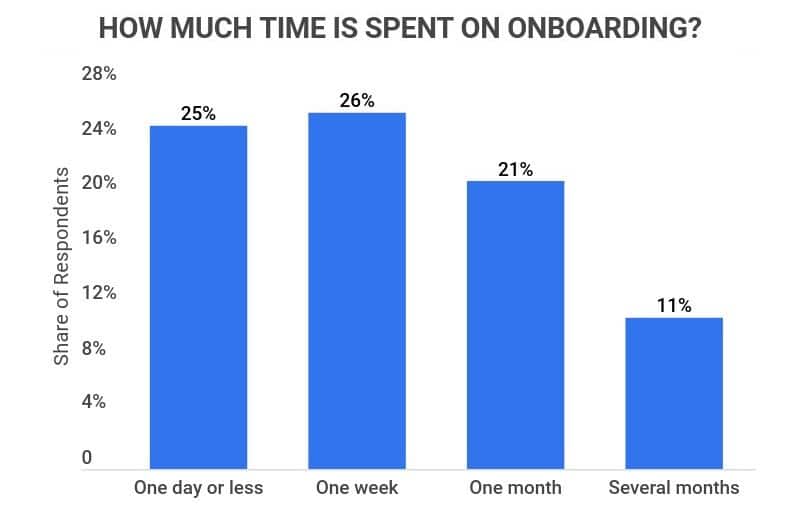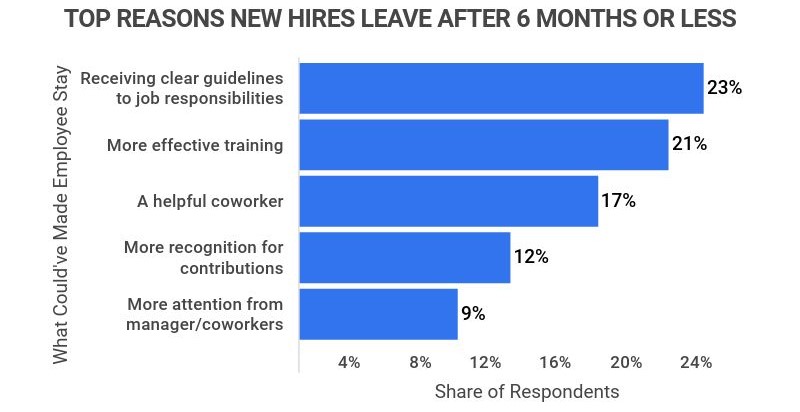- HR Statistics
- Average Labor Cost Percent Of Sales
- Average Time to Reach Profitability At A Startup
- Office Space Per Employee
- Recruitment Statistics
- Employee Engagement Statistics
- Work-Life Balance Statistics
- BYOD Statistics
- Paternity Leave Statistics
- Onboarding Statistics
- Average Paid Maternity Leave In Us
- Average Cost Of A Bad Hire
- Employee Theft Statistics
- Paid Family Leave Statistics
- Cost Of Hiring Statistics
- Employee Turnover Statistics
- Average Cost Of Employer Sponsored Health Insurance Statistics
- Sexual Harassment In The Workplace Statistics
- HR Statistics
- PTO Statistics
Research Summary. Onboarding a new employee can be a more daunting task than many realize, including things such as advertising expenses, recruiting events, fees for a recruitment software, relocation expenses, among other things. After researching the subject, our data analysis led to the following conclusions:
-
It costs a little over $1,500 to onboard a new hire, on average
-
Organizations with strong onboarding processes increase new hire retention by 82% and improve the productivity by 70%.
-
88% of employees believe that their company doesn’t do a great job when it comes to onboarding new employees.
-
58% of organizations have onboarding programs that primarily involves processes and paperwork.
-
Employees who attend a structured orientation program are 69% more likely to remain at the company for at least three years.
-
The average new hire is assigned 41 administrative tasks to complete.
-
17% of employees leave their new job between the first week and the third month of a new job.
For further analysis, we broke down the data in the following ways:
Cost of Hiring + Training | Employee Retention | Common Challenges

General Onboarding Statistics
Onboarding sets the tone for a new employee. It should help them understand what to expect at their new company and job while setting realistic expectations, establishing clear job roles and responsibilities, and achievable benchmarks.
A poor onboarding system can lead to high employee turnover and reduced productivity. Companies that do not give onboarding the attention it deserves are often at risk of losing new employees much sooner than they may have previously thought. Consider these statistics:
-
26% of employers reported that their onboarding process took one week.
One in four employers reported that their onboarding process takes a day or less, while 21% reported the process taking over the course of a month. Only 11% said their company offers onboarding over the course of three months or more.
-
One-third of approximately 1,000 survey respondents said they had quit a job within six months of starting it.
Almost 17% of these individuals left between the first week and the third month of a new job. This means, on average, one out of every six new hires is lost to companies within the first three months.
-
50% of employees voluntarily leave in the first two years of employment.
This could be for a variety of reasons, but career advancement, pay and benefits, and lack of fit are three of the most common reasons for employee turnover.
A comprehensive onboarding system can significantly reduce this statistic by covering those three things in detail during training in an effort to set realistic expectations and direction on how to fix them if necessary.

Onboarding Statistics by Cost of Hiring and Training
Though onboarding might initially seem costly both in terms of finances and time, the cost of not providing significant onboarding or training can actually cost businesses more money in the long run. The following statics demonstrate how important onboarding truly is for an organization and its new employees.
-
The average cost of training an employee is $1,075, as of 2017.
However this cost increases dramatically to $1,886 for companies with fewer than 1,000 employees. Large organizations with 10,000 or more employees spend only $399 on training.
The average cost of employee training also rose by 53% between 2015-2017, while training became even cheaper for large companies.
-
Companies that prioritize employee training make a median revenue of $169,100 per employee.
This is a stark comparison to companies that do not prioritize training or onboarding procedures. The typical employee makes $82,800 — less than half.
-
Approximately 35% of companies spend zero dollars on onboarding.
This number is quite shocking, considering a majority of this percentage spend approximately $11,000 on recruitment and turnover costs. Adequately onboarding your new employees is equally if not more important than acquiring new talent.
-
Employees are 69% more likely to stay with a company for three years if they experience a great onboarding process.
Additionally, new hires with longer onboarding programs report being more proficient in their jobs four months sooner than companies that do not offer onboarding processes.

Onboarding Statistics and Employee Retention
Onboarding is a significant piece of the puzzle when bringing in a new employee. The statistics are alarming, especially for companies that have not invested in onboarding and training. In the long run, providing adequate onboarding for employees is more financially effective than not.
-
23% of employees who quit within 6 months say that clear guidelines on their responsibilities would have helped them stay at the job.
“More effective training” was the next most popular opinion, with 21%. Together, this means bad onboarding experiences account for 44% of employees lost in the first 6 months of being hired.
-
78% of organizations invested in onboarding reported increases in revenue in the last fiscal year.
64% of those companies saw positive gains in most of their organizational KPIs, and 54% saw significant gains in employee engagement metrics.
-
22% of employees say they’d look for another job if they didn’t receive a good introduction or onboarding, while 41% said they might look elsewhere.
Additionally, 51% of employees said they’d go “above and beyond” if given a good induction and onboarding. 64% of invested onboarders reported decreased turnover, compared to 37% in other organizations that do not prioritize onboarding.
-
The cost of hiring a new employee is $4,129, while the cost of onboarding new hires falls, on average, a little over $1,500.
Remember that hiring a new employee could include internal recruiting costs, external recruiting costs, as well as other factors, including job fairs or events.

Onboarding Statistics by Common Challenges
Although important, onboarding can come with its own list of challenges. While this process will look different for every organization, the following statistics show that onboarding is really what you make of it.
-
The average new hire will be assigned 41 administrative tasks to complete.
This can include desk set-up, as well as documents to sign, upload, or acknowledge. They will also have ten outcomes or learning goals regarding culture, market knowledge, and roles and responsibilities of the job.
-
88% of organizations don’t onboard well.
Only 12% of employees strongly agree that their organization does a great job of onboarding.
This is a huge missed opportunity for many businesses, leaving only about one in every ten employees who think their employer is onboarding them and their colleagues effectively.
-
Organizations with a strong onboarding process improve productivity by over 70%.
Additionally, a strong onboarding process helps to engage and retain employees from their first day of employment. The best onboarding programs extend throughout an employee’s first 90 days and may even extend up to a full year, depending on the job.
-
The biggest onboarding challenge is inconsistent application.
This means that the onboarding process isn’t the same across the board. This may be due to a number of things such as competing priorities, manager accountability, or lack of resources.
Onboarding Statistics FAQ
-
What does employee onboarding mean?
Employee onboarding is the process of integrating a new hire with a company, its culture, and other colleagues. Employee onboarding includes getting a new hire the tools and information they need to become a productive member of the team.
-
What is included in onboarding?
Onboarding includes learning about your work environment, gaining access to various IT tools, introductions to important colleagues and peers, info on policies and procedures, filling out paperwork, job training, and any other administrative matters.
-
What percentage of employees believe their employers do a great job with onboarding?
12% of employees feel that their employers do a great job with onboarding. And those employees who feel their company has a great onboarding program are almost three times as likely to report a high level of job satisfaction than an average employee.
It’s no wonder that most employees find their onboarding experience underwhelming — 35% of companies don’t spend any money at all on onboarding and 58% of companies focus their onboarding experience mostly on paperwork and policy matters.
-
Do you get paid for onboarding?
Yes, you get paid for onboarding. Job training is an essential part of the job, and all the time you spend on onboarding tasks should be paid. Under FLSA guidelines, the only onboarding tasks that are allowed to not be paid must meet all four of the following criteria: the event is outside business hours, you can choose not to go, it is not work-related, and no work is being completed.
Basically, if it’s an optional after-work social event and everyone is “off-the-clock,” then you are too. But regular onboarding tasks that you perform during normal work hours alongside your colleagues are simply part of the job you’ve been hired for.
-
Is onboarding the same as training?
No, onboarding is not the same as training. Training is only one part of onboarding, which also includes orientation, administrative tasks like filling out necessary paperwork, learning about company policies, and meeting your team and other colleagues.
Employers who want the best results from new hires will ensure that training is also a major part of their onboarding experience, but it’s not always a given that onboarding for a new job will involve formal training time.
Conclusion
It’s clear that onboarding a new employee is beneficial for the company, managers, teams, and the new employee. Additionally, it’s important to remember that onboarding doesn’t only fall on human resources’ shoulders.
Onboarding a new hire isn’t just about filling out forms and ensuring all of their information is right. It’s a consistent process that may extend out as far as 90 days or longer.
Although training and guidance are important through this process, it’s important to establish goals with your new employee as well as maintain weekly check-ins to make sure they are getting the support necessary to do their job well.
Onboarding is an opportunity. It’s the first view a new hire has into the company and will help them understand the business, their performance goals, and how those activities contribute to the overall bottom line for an organization.
References
-
CareerBuilder. “Thirty-Six Percent of Employers Lack a Structured Onboarding Process for New Employees, According to New CareerBuilder Survey.” Accessed on September 17, 2021.
-
SHRM. “Onboarding Key to Retaining, Engaging Talent.” Accessed on September 19, 2021.
-
Manila Recruitment. “Understanding Why Employees Leave: 10 Turnover Statistics You Need to Know.” Accessed on September 19, 2021.
-
Shift eLearning. “The True Cost of Not Providing Employee Training.” Accessed on September 19, 2021.
-
Enboarder. “12 Must-Know Employee Engagement and Onboarding Stats.” Accessed on September 19, 2021.
-
O.C. Tanner. “An Onboarding Checklist For Success.” Accessed on September 19, 2021.
-
Enboarder. “Are You Losing Your Best People Because of Your Onboarding?” Accessed on September 19, 2021.
-
Investopedia. “The Cost of Hiring a New Employee.” Accessed on September 19, 2021.
-
Brandon Hall Group. “The True Cost of a Bad Hire.” Accessed on February 13, 2022.
-
Gallup. “State of the American Workplace.” Accessed on February 13, 2022.
-
SHRM. “Onboarding New Employees: Maximizing Success.” Accessed on February 13, 2022.
- HR Statistics
- Average Labor Cost Percent Of Sales
- Average Time to Reach Profitability At A Startup
- Office Space Per Employee
- Recruitment Statistics
- Employee Engagement Statistics
- Work-Life Balance Statistics
- BYOD Statistics
- Paternity Leave Statistics
- Onboarding Statistics
- Average Paid Maternity Leave In Us
- Average Cost Of A Bad Hire
- Employee Theft Statistics
- Paid Family Leave Statistics
- Cost Of Hiring Statistics
- Employee Turnover Statistics
- Average Cost Of Employer Sponsored Health Insurance Statistics
- Sexual Harassment In The Workplace Statistics
- HR Statistics
- PTO Statistics





